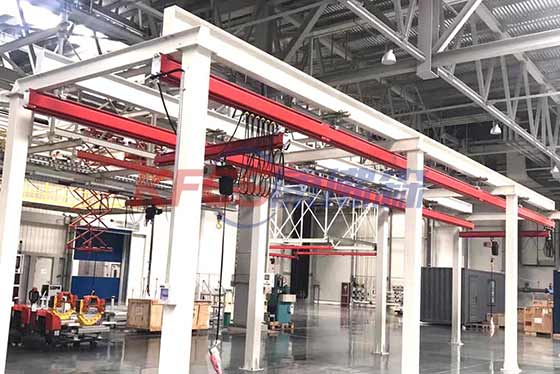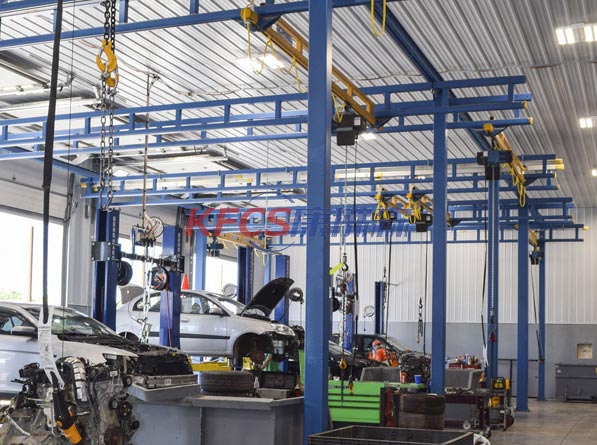What is the difference between flexible KBK rail crane and rigid combined suspension crane?
Flexible KBK rail crane
 It is composed of supporting column, auxiliary beam, running track, main beam, electric hoist, power supply system and other main components. The plane lifting operation of various materials can be completed quickly and safely. The self weight of its walking mechanism is very light, the operation is light, and it can move at will. It can also be simply hung on the top structure of the plant without additional columns, which improves the space utilization and has good economy.
The combined self-supporting crane system of rigid KBK crane adopts C-shaped track, which adopts the closed track design with high strength and light self weight, which effectively reduces the wear of trolley and hoist wheels. In case of insufficient lifting points, truss steel profile rail can be used to strengthen the bearing of profile rail, so as to realize large span and reduce the number of hangers. The steel truss design can make the lifting span up to 11m and reduce the possibility of the support column hindering the work site, so that the self-supporting crane is widely used in various industries.
Rigid combined crane (rigid combined suspension crane)
It is composed of supporting column, auxiliary beam, running track, main beam, electric hoist, power supply system and other main components. The plane lifting operation of various materials can be completed quickly and safely. The self weight of its walking mechanism is very light, the operation is light, and it can move at will. It can also be simply hung on the top structure of the plant without additional columns, which improves the space utilization and has good economy.
The combined self-supporting crane system of rigid KBK crane adopts C-shaped track, which adopts the closed track design with high strength and light self weight, which effectively reduces the wear of trolley and hoist wheels. In case of insufficient lifting points, truss steel profile rail can be used to strengthen the bearing of profile rail, so as to realize large span and reduce the number of hangers. The steel truss design can make the lifting span up to 11m and reduce the possibility of the support column hindering the work site, so that the self-supporting crane is widely used in various industries.
Rigid combined crane (rigid combined suspension crane)
 It is composed of supporting steel structure, fixed rail, main beam, electric hoist, power supply system, safety system and other main components. It is used for material transportation between work units. It is simple and reliable to use, light to move, accurate positioning, and reduces the labor intensity of workers to the greatest extent. High quality cold-rolled section steel and solid truss structure can ensure the reliability and safety of operation, and ensure a longer service life under the lowest maintenance conditions.
It is composed of supporting steel structure, fixed rail, main beam, electric hoist, power supply system, safety system and other main components. It is used for material transportation between work units. It is simple and reliable to use, light to move, accurate positioning, and reduces the labor intensity of workers to the greatest extent. High quality cold-rolled section steel and solid truss structure can ensure the reliability and safety of operation, and ensure a longer service life under the lowest maintenance conditions.
 It is composed of supporting column, auxiliary beam, running track, main beam, electric hoist, power supply system and other main components. The plane lifting operation of various materials can be completed quickly and safely. The self weight of its walking mechanism is very light, the operation is light, and it can move at will. It can also be simply hung on the top structure of the plant without additional columns, which improves the space utilization and has good economy.
The combined self-supporting crane system of rigid KBK crane adopts C-shaped track, which adopts the closed track design with high strength and light self weight, which effectively reduces the wear of trolley and hoist wheels. In case of insufficient lifting points, truss steel profile rail can be used to strengthen the bearing of profile rail, so as to realize large span and reduce the number of hangers. The steel truss design can make the lifting span up to 11m and reduce the possibility of the support column hindering the work site, so that the self-supporting crane is widely used in various industries.
Rigid combined crane (rigid combined suspension crane)
It is composed of supporting column, auxiliary beam, running track, main beam, electric hoist, power supply system and other main components. The plane lifting operation of various materials can be completed quickly and safely. The self weight of its walking mechanism is very light, the operation is light, and it can move at will. It can also be simply hung on the top structure of the plant without additional columns, which improves the space utilization and has good economy.
The combined self-supporting crane system of rigid KBK crane adopts C-shaped track, which adopts the closed track design with high strength and light self weight, which effectively reduces the wear of trolley and hoist wheels. In case of insufficient lifting points, truss steel profile rail can be used to strengthen the bearing of profile rail, so as to realize large span and reduce the number of hangers. The steel truss design can make the lifting span up to 11m and reduce the possibility of the support column hindering the work site, so that the self-supporting crane is widely used in various industries.
Rigid combined crane (rigid combined suspension crane)
 It is composed of supporting steel structure, fixed rail, main beam, electric hoist, power supply system, safety system and other main components. It is used for material transportation between work units. It is simple and reliable to use, light to move, accurate positioning, and reduces the labor intensity of workers to the greatest extent. High quality cold-rolled section steel and solid truss structure can ensure the reliability and safety of operation, and ensure a longer service life under the lowest maintenance conditions.
It is composed of supporting steel structure, fixed rail, main beam, electric hoist, power supply system, safety system and other main components. It is used for material transportation between work units. It is simple and reliable to use, light to move, accurate positioning, and reduces the labor intensity of workers to the greatest extent. High quality cold-rolled section steel and solid truss structure can ensure the reliability and safety of operation, and ensure a longer service life under the lowest maintenance conditions.
